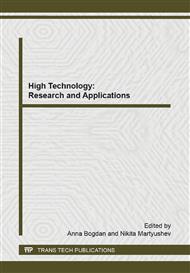[1]
I.M. Goncharenko, Yu. F. Ivanov, N.N. Koval, P.M. S.V. Grigoriev, I.V. Lopatin, Yu. A. Kolubaeva, G.A. Pribytkov, E.N. Korosteleva, In Proc. of 7th Int. Conf. on Modification of Materials with Particle Beams and Plasma Flows (2004) 167–170.
Google Scholar
[2]
G.A. Pribytkov, V.V. Korzhova, E.N. Korosteleva, Solid-phase sintering of Al-Cr(Si, Ti) powder foundry alloys obtained by self-propagating high temperature synthesis, Russian Journal of Non-Ferrous Metals. 54 (2013) 252-260.
DOI: 10.3103/s1067821213030140
Google Scholar
[3]
J. Musil, R. Daniel, Structure and mechanical properties of magnetron sputtered Zr–Ti–Cu–N films, Surface and Coatings Technology, 166, 2–3 (2003) 243–253.
DOI: 10.1016/s0257-8972(02)00819-8
Google Scholar
[4]
S. Veprek, A. Niederhofer, K. Moto et al. J. Surf. and Coat. Technol, 249 (2005)133–134.
Google Scholar
[5]
S.N. Sorokova, A.G. Knyazeva, Solid phase synthesis of coating on the base under the electron beam surfacing, Applied Mechanics and Materials, 379 (2013) 60-65.
DOI: 10.4028/www.scientific.net/amm.379.60
Google Scholar
[6]
A.G. Knyazeva, S.N. Sorokova, Numerical Study of the Influence of the Technological Parameters on the Composition and Stressed–Deformed State of a Coating Synthesized under Electron–Beam Heating, Theoretical Foundations of Chemical Engineering 42 (4) (2008).
DOI: 10.1134/s0040579510020089
Google Scholar
[7]
N.V. Martyushev, Leaded-tin bronze destruction mechanism, (2012) Proceedings - 2012 7th International Forum on Strategic Technology, IFOST (2012).
DOI: 10.1109/ifost.2012.6357597
Google Scholar
[8]
S.N. Sorokova, O.O. Onoprienko, A.G. Knyazeva, Modeling of phase transformations in the Ti-Cu system under controlled heating, Russian Physics Journal, 12/2 (2013).
Google Scholar
[9]
A.G. Merzhanov, Theory of Gasless Combustion, Preprint. Chernogolovka, (1973).
Google Scholar
[10]
N.V. Martyushev, E.N. Pashkov, Bronze sealing rings defects and ways of its elimination, Applied Mechanics and Materials 379 (2013) 82 - 86.
DOI: 10.4028/www.scientific.net/amm.379.82
Google Scholar
[11]
A.G. Knyazeva, Solid-phase combustion in a plane stress state. 1. Stationary combustion wave, Journal of Applied Mechanics and Technical Physics, 51 (2) (2010) 164-173.
DOI: 10.1007/s10808-010-0025-y
Google Scholar
[12]
T.V. Nekrasova, A.G. Melnikov, N.V. Martyushev, Creation of ceramic nanocomposite material on the basis of ZrO2-Y2O3-Al2O3 with improved operational properties of the working surface, Applied Mechanics and Materials 379 (2013) 77 - 81.
DOI: 10.4028/www.scientific.net/amm.379.77
Google Scholar


